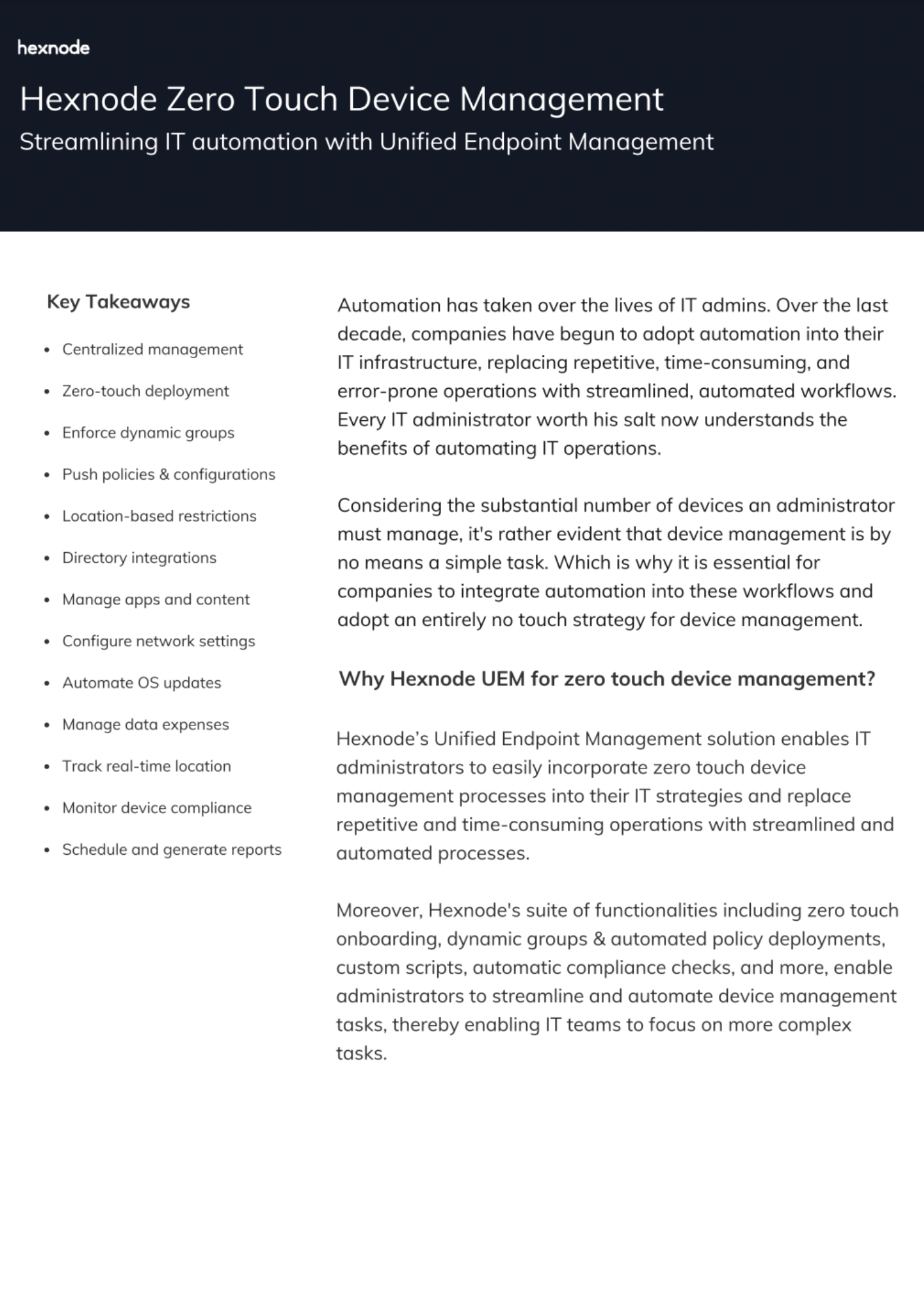How Windows provisioning helps SMEs
Dive in to learn more about how Windows provisioning can help SMEs.

Get fresh insights, pro tips, and thought starters–only the best of posts for you.

The amount of work done to get ONE device work-ready is enough to make even the most patient person pull out his hair. Let alone the sleep-deprived, highly caffeinated IT guy trying to set up hundreds of thousands of those devices! Add to it the fact that each device is different. They need to be handled according to their framework and architecture. Yup! All the patience in the world wouldn’t be enough.
The different types of devices may be a problem that we can’t do away with. After all, variety is the spice of life. But what if there was a way to set up all devices of a particular type together? Say, with a click! Just a click might be a stretch, but you get the point. Configurations, profiles, and policies on the one hand and a list or a CSV file of devices on the other. A few keystrokes and a suitable platform to bring the two hands together and, lo and behold, all the devices have been provisioned!
Welcome to the wonders of bulk deployment!
Manually configuring each device one after the other is not efficient in a world where every second counts. After all, manual efforts can’t beat the accuracy and efficiency of an automated system. In addition, there is extra pressure as the team has to be extra cautious. Adding on to that, the massive number of devices makes the entire process cumbersome.
Bulk enrollment processes provide for quickly configuring network and security services on the devices. It allows easy visibility of the hardware, software, and security status to authorized personnel within an organization. Furthermore, the organization can reassign licenses and perform remote actions like locking or wiping devices. Automating configuration tasks decreases employees’ hours, thus ensuring more time to focus on other high-priority tasks and reducing operational costs.
Apple has always prided itself on the security and privacy that it offers to its users. So much so that it becomes a hassle when it comes to managing the devices using third-party software. This particular problem, however, has been addressed by the company. Apple Device Enrollment Program (DEP), recently renamed Automated Device Enrollment, helps provide the necessary control over the devices used in a corporate setting. Accordingly, it is an efficient bulk enrollment platform for corporate Apple devices.
Apple DEP is popular because of its functional utilities like mandatory irreversible UEM enrollment, wireless supervision, and customizable streamlined setup assistant. To enroll in DEP, purchase your devices directly from Apple or authorized participating resellers. In case you didn’t purchase your devices from an Apple-authorized reseller, fret not! Apple allows the use of Apple Configurator to add them to DEP. Moreover, mandatory irreversible enrollment ensures that all the corporate Apple devices enroll in the UEM solution adopted by the organization. In addition, the administrators do not have to set the configurations for the customized setup assistant separately for each device, making it easier to configure many devices at once.
The setup flow essentially involves:
Connecting the device to the Wi-Fi ensures that the device is locked into the UEM solution, thus allowing remote management.
Android’s Zero-Touch Enrollment program is yet another bulk deployment method that caters to the provisioning of Android devices. A large chunk of the working population is comfortable with Android devices. Undeniably, the necessary provisioning of these devices to protect the organization from corporate data leakage is a must in the modern digital market. Android’s Zero Touch enrollment helps fix the issues of corporate data leakage by managing Android devices using an appropriate UEM solution.
Android Zero Touch promises a better user experience ensured by faster device delivery and non-complicated activation processes. It also alleviates the demands on the IT team by automating the deployment process. In addition, Android Zero Touch offers control, choice, and productivity. It helps manage n-number of devices by enforcing management to protect the organization’s data. Moreover, the program ensures that remote management is intact even after the device is factory reset. Maximizing Android device deployment and productivity gain is an added perk of the program.
Samsung Knox Mobile Enrollment (KME) is another bulk enrollment program that works to achieve automated and seamless setup configurations for Samsung devices in a corporate scenario. KME is a not-so-complicated enrollment program that equips organizations with the means to control and manage the Samsung devices deployed in their work environment. Accordingly, it prevents the devices from becoming unsuspecting entry points for security risks. In addition, it automates the process to help organizations save time and money on manual labor.
Some key features of KME include automated configurations that help streamline the device deployment process in bulk and easy UEM enrollment. And thus, Samsung KME does away with the need to manually enroll devices. The automated process is quick and easy to implement and provides for the automatic re-configuring of devices in case of a factory reset or hard reset.
KME makes the management of Samsung devices a whole lot easier. As soon as the devices are powered up and set up with the network, the UEM configurations are applied. If factory reset, lost or stolen devices will be re-enrolled with the UEM, thus safeguarding the organization against data leak and theft. Thus helping locate and secure lost or stolen devices. Multiple UEM configurations per account can be managed using KME, thus enabling organizations with a complex UEM environment to manage their large fleet of devices with the proper UEM configurations. Depending on its integration with a UEM solution, KME provides various advanced restrictions and functionalities. These include restrictions on Bluetooth, camera, Wi-Fi, and data roaming.
As soon as the devices are powered up and set up with the network, the UEM configurations are applied.
The entire process for bulk device deployment can be chalked up to a few simple steps:
Windows Autopilot is a collection of tools and technologies employed to configure devices for productive use. Predominantly configures Windows PCs or HoloLens 2 devices.
The features of this bulk deployment method include:
Windows Autopilot has managed to automate the process of adding devices to the Azure active directory using the Hybrid Azure AD join feature. Furthermore, it provides for the automated enrolling of devices into UEM solutions without much user interference. In addition, it provides for the configuration of the BitLocker encryption settings. Thus the applied configurations guide the automated encryption process.
Windows autopilot markets itself on features that include skipping the setup wizard, restricting admin account creation and remote reset. Windows Autopilot takes advantage of the OEM-optimized Windows client when initially deploying new Windows devices. No need to keep up with maintaining custom images and drivers for every device model because this version is preinstalled on the device. It can change the edition of Windows being used to support advanced features. Stolen/lost devices can be reset remotely by the IT team using Windows Autopilot. Additionally, Windows Autopilot allows remotely redeploying the device to some other user.
Many UEM solutions have Windows Autopilot on their roadmaps due to the extensive set of features that it offers with a sense of flexibility.
Start implementing automation into your IT strategies right away with Hexnode's Zero-Touch Device Management solution to swap out time-consuming, repetitive chores with effective, automated ones.

Featured resource
Hexnode Zero Touch Device Management
Windows package provisioning is yet another bulk enrollment method. The provisioning package file is essentially just a bunch of configuration settings grouped in a container equivalent structure, with the file extension “.ppkg.” Any Windows 10 device can create the provisioning package file. The IT admins can then use this file to deploy devices in bulk.
The two features that make this particular mode of enrollment so appealing are the one-time setup and the ease with which it facilitates bulk enrollment of devices. Accordingly, the enrollment process is as easy as powering on the device, connecting to a network and installing the .ppkg file. Once done, the device is enrolled into the UEM solution.
In order to enroll devices using the provisioning package enrollment method the fundamental step remains the creation of a provisioning package file.
Read Only Memory or ROM is a non-volatile memory device present in computers and other electronic devices. Certain UEM solutions have provisions for enrolling Android devices by configuring the ROM.
UEM solutions used in tandem with a custom ROM can help maximize the productivity and efficiency of the workforce by exploiting the additional functionalities and restrictions offered. Devices configured with a custom ROM can have apps pushed to them silently. They also have provisions for the silent removal of unwanted apps. So, no unnecessary pop-ups or notifications. This would ensure that the users can better focus as they will have an uninterrupted workflow. Other features like remote power off and reboot and making the UEM app unremovable are also possible using this mode of enrollment.
The entire enrollment process comes down to three simple steps:
When time is of the essence, bulk device deployment comes in handy to deploy multiple devices quickly. Bulk deployment methods should work in tandem with UEM solutions. However, not all UEM systems can interface quickly with deployment methods. Therefore, asking your UEM providers if their solutions can handle these methods is crucial.
Simply put, companies intending to implement deployment methods in bulk should always consider the kind of device, its OS and version, and its compatibility with the UEM solution. Never forget! Not every deployment method can support all UEM solutions, operating systems, and versions.
Forget the hassle of getting your devices work-ready. Instead, let Hexnode worry about getting your devices ready for work!!
Join now